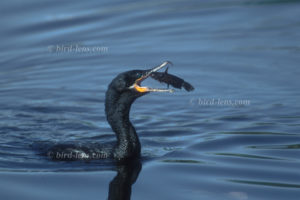 A few kilometers the Transpantaneira officially begins, a bridge give views to a very open countryside. There is busy fighting in the low water beside the bridge. It is fascinating to observe the fish-catching Neotropic Cormorants (Phalacrocorax brasilianus). A feast for the eyes are the Cormorants, who playfully fetch the fish out of the water, hold them with their beak tips, do throw fish at 20m before my eyes and devour them. Again and again one appears, sometimes it has even impaled a fish with his lower beak. The fish are not big; it could be a small catfish species. Nevertheless, the Neotropic Cormorants obviously take an extensive play with the prey. It seems that a mutual fish hunt is also carried out in the group, with several individuals swimming in a row on the water. This is all associated with a lot of excitement in the group and mutual assertiveness gives nice action packed pictures.
A few kilometers the Transpantaneira officially begins, a bridge give views to a very open countryside. There is busy fighting in the low water beside the bridge. It is fascinating to observe the fish-catching Neotropic Cormorants (Phalacrocorax brasilianus). A feast for the eyes are the Cormorants, who playfully fetch the fish out of the water, hold them with their beak tips, do throw fish at 20m before my eyes and devour them. Again and again one appears, sometimes it has even impaled a fish with his lower beak. The fish are not big; it could be a small catfish species. Nevertheless, the Neotropic Cormorants obviously take an extensive play with the prey. It seems that a mutual fish hunt is also carried out in the group, with several individuals swimming in a row on the water. This is all associated with a lot of excitement in the group and mutual assertiveness gives nice action packed pictures.
The Neotropic Cormorants inhabits the Americas from the southern USA to Tierra del Fuego. The species is quite easy to determine. Features indicative of an Neotropic Cormorant are a pointed rear surface of the featherless skin connecting the lower jaw of the beak with the bird’s neck, a long, wedge-shaped tail and a rather small beak with little pronounced thickening at the top. Like all cormorants, the Neotropic Cormorants prefers to prey trailing fish under water and then catching it. The hunt is often done in groups, with several individuals swimming in a row on and under the water, driving the prey fish towards the shore, where they can be more easily captured
It’s as impressive as the dirt track called “Transpantaneira” – it’s not more – runs mostly on a causeway through the vast, slightly flooded marshland. Sometimes you practically enthrone above the action, then again the road leads only slightly higher than the water level. For the excavation of the dam the engineers have probably taken soil directly from the ground next to the dam. As a result, the water next to the dam is relatively deep compared to the rest of the flood plain. In summer – i.e. the dry season – most fish and other water inhabitants accumulate in the deeper water. Of course this magically attracts many fish-eating birds. The Pantanal along the Transpantaneira is characterized by endless expanses of extensively grazed open land and seasonal forests. The area is criss-crossed by rivers and waters, interspersed with ponds and lakes. At the end of the dry season, the latter had retreated to small areas, but were visited all the more intensely by otters, herons, storks and of course the cormorants.
To cope with the growing demand for top shots of the rarer species of the Palearctic Bird-Lens is keen to enrich the range of pictures of birds you can find in the western palearctic. Trips to remote places like this one to capture images not only of rare birds of western palearctic were very successful. The nice image of the blog is only a first impression, what you will find in the gallery in the “Picture Shop” very soon. Just give bird-lens.com a message, if bird-lens.com could serve you with an image needed before the new pictures are online.